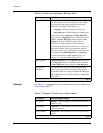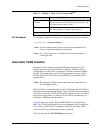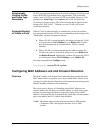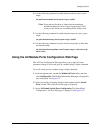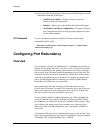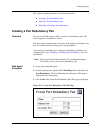
8-36 User Guide for the Avaya P580 and P882 Multiservice Switches, v6.1
Chapter 8
Table 8-8. VLAN Binding Options
Option Definition
Static Assigns VLAN membership manually, using the VLAN
Switch Ports page described in “Creating and
Implementing VLANs” in Chapter 6, “Using VLANs,
Hunt Groups, and VTP Snooping.”
Bind to All Binds this port to all VLANs known to the switch. This
is an appropriate mode for switch-to-switch
connections.
Note: When a tagged IEEE 802.1Q packet arrives on
a port that is set to bind to all and the VLAN
does not exist on the switch, the packet is
forwarded on to the VLAN assigned to the port
default VLAN for that port. To prevent
unintended forwarding of unknown VLAN
traffic to the port’s default VLAN, configure
the port default VLAN to Discard. The
automatic VLAN creation feature will not work
if the port’s default VLAN is the discard
VLAN, because the switch does not learn for
this VLAN.
Bind to Received Binds this port to any VLAN it receives traffic from.
Note: If Automatic VLAN Creation is enabled, the
port binds to previously unknown VLANs and
a VLAN entry is added to the switch VLAN
table. If Automatic VLAN Creation is disabled,
the port does not bind to any VLAN unknown
to the switch.
Table 8-9. Avaya P580 and P882 Multiservice Switch VLAN Table
Name ID Group ID AFT Index
Default 1 2 1
Discard 4097 3 3
Net90 90 90 7
*autoVlan100 100 100 11
* Automatically created by the switch software. All others created manually.









